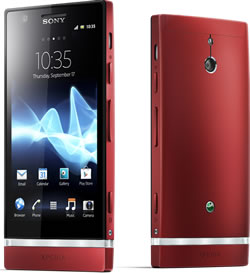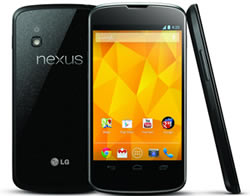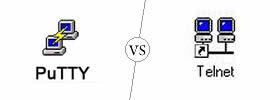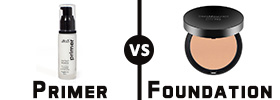Difference between Sony Xperia P and Nexus 4
Key difference: Sony Xperia P features a 4-inch TFT touch screen that allows up to 4-touch capabilities. The screen is scratch resistant and has a shatter proof coating. The touch screen provides approximately 275 ppi pixel density along with WhiteMagic technology, which adds an extra white pixel with the already present red, blue and green. The Nexus 4 is Google's fourth Nexus-branded Android smartphone. It was produced in collaboration with LG Electronics. The phone runs on the Android 4.2 (Jelly Bean) operating system, which was launched with the phone.
 Sony is a prominent technology company and is known best for its electronics such as phones, TVs, gaming systems, etc. The constant dynamic nature of technology ensures that we always have a better and more forward technology than the one we had a month ago. The price of this dynamic technology is also high, the constant updating of technology requires people have that much cash on hand. However, many companies such as Sony know that not many people have that much cash on hand for disposal, hence has launched mid-range phones such as Xperia P that allows the people to experience the best of both worlds: technology and affordable pricing. The Xperia P was launched in May 2012 and continues to be a major player in the market.
Sony is a prominent technology company and is known best for its electronics such as phones, TVs, gaming systems, etc. The constant dynamic nature of technology ensures that we always have a better and more forward technology than the one we had a month ago. The price of this dynamic technology is also high, the constant updating of technology requires people have that much cash on hand. However, many companies such as Sony know that not many people have that much cash on hand for disposal, hence has launched mid-range phones such as Xperia P that allows the people to experience the best of both worlds: technology and affordable pricing. The Xperia P was launched in May 2012 and continues to be a major player in the market.
Sony Xperia P features a 4-inch TFT touch screen that allows up to 4-touch capabilities. The screen is scratch resistant and has a shatter proof coating, allowing the screen to endure minor scratches and everyday scuffs without sacrificing on the quality. The touch screen provides approximately 275 ppi pixel density, though not the best ppi compared to the heavy contenders but the quality of the screen is not sacrificed. This is mostly because of the company’s WhiteMagic technology, which adds an extra white pixel with the already present red, blue and green. The extra pixel generates a higher level of brightness that does not cloud the phone when using it under direct sunlight.
The phone is a little bulky in nature, but it is easy to become accustomed to when holding it for longer periods of time. The phone is also a little heavier compared to similar phones, but again not something that lets the user forget of the other great features of the phone. The phone is encased in a plastic chassis, which is quite smooth to hold but is also prone to many visible scratches and chips. The device has a clear plastic border on the front that also doubles as a cover up for the antenna. Above the plastic border reside buttons Home button, back button and Menu button. The power button, the volume rocker and the physical camera button is on the right side of the device, while the left sides hosts a variety of ports including the SIM card slot.
Under the hood, the device is powered by 1 GHz Dual-core processor and hosts the company’s Timescape UI. The user interface is quite smooth and does not glitch when shifting between the screens and the apps. The device runs on 1 GB RAM and comes with an internal storage capacity of 16 GB. Of the 16 GB, only 13 GB is available to the user and it is not expandable. The device houses an 8 MP Autofocus rear camera and a VGA (0.3 MP) front camera, which is a little bit of a letdown. The Exmor R technology ensures that the rear camera provides sharp, clear images, while the front camera does not live up to the same quality. Though initially powered by Android v2.3, the device is now available with Android v4.0, which no status as of yet for v4.1 upgrades. The phone also comes with additional features such as Motion gaming, MobiSystems’ OfficeSuite 5, Wi-Fi hotspot, DLNA, USB On-the-go, Native USB tethering and NFC capabilities. The Xperia P houses a non-removable 1305 mAh battery, which provides a decent battery life and lasts almost a day. With the amount of features that are offered with the phone, the price tag is expected to be quite high; however, the price is quite affordable and will not make that much of a dent in the user’s pocket.
 A number of these companies’ smartphones and tablets run on Android. Android is an open source software, which means that the code is freely available for modification and distribution by device manufacturers, wireless carriers and enthusiast developers. Among the number of various companies, Google has also launched its own line of smartphones based on Android, called the Google Nexus. Each device in the Nexus line is produced via collaboration between Google and a leading original equipment manufacturer (OEM) partner.
A number of these companies’ smartphones and tablets run on Android. Android is an open source software, which means that the code is freely available for modification and distribution by device manufacturers, wireless carriers and enthusiast developers. Among the number of various companies, Google has also launched its own line of smartphones based on Android, called the Google Nexus. Each device in the Nexus line is produced via collaboration between Google and a leading original equipment manufacturer (OEM) partner.
The Nexus devices in general have an advantage over other devices in that the Android in the Nexus devices is pure, i.e. the Android does not have any manufacturer or wireless carrier modifications to it, such as a custom graphical user interface. The Android also has an unlockable bootloader to allow further development and end-user modification, all of which is usually blocked on other Android smartphones.
The Nexus 4 is Google's fourth Nexus-branded Android smartphone. It was produced in collaboration with LG Electronics. The phone features a 1.5 GHz quad-core Snapdragon S4 Pro processor, 2 GB of RAM, 8 or 16 GB of internal storage, front facing 1.3 megapixel camera and an 8 megapixel rear camera and a micro-SIM card tray. The phone runs on the Android 4.2 (Jelly Bean) operating system, which was launched with the phone. The phone also features a new camera technology, called the Photo Sphere. This allows one to take 360 deg Panorama shots.
The information for the detailed table about the two phones has been taken from Sony Mobile website, expertreviews.co.uk, Google website, knowyourmobile.com and GSMArena.com.
|
|
Sony Xperia P |
Nexus 4 |
|
Launch Date |
May 2012 |
November 2012 |
|
Company |
Sony |
Google; designed in collaboration with and manufactured by LG Electronics. |
|
Size |
122 x 59.5 x 10.5 mm |
133.9 x 68.7 x 9.1 mm (5.27 x 2.70 x 0.36 in) |
|
Display |
4-inch scratch-resistant TFT touchscreen |
4.7 inches True HD IPS Plus capacitive touchscreen, 16M colors |
|
Screen |
960 x 540 pixels (~275 ppi pixel density), 16 million colors |
768 x 1280 pixels, (~318 ppi pixel density) |
|
Protection |
Scratch-resistant, shatter proof sheet on mineral glass |
Corning Gorilla Glass 2 |
|
Weight |
120 grams |
139g (4.90 oz) |
|
2G Network |
GSM GPRS/EDGE 850, 900, 1800, 1900 |
GSM 850 / 900 / 1800 / 1900 |
|
3G Network |
UMTS HSPA 850, 900, 1900, 2100 |
HSDPA 850 / 900 / 1700 / 1900 / 2100 |
|
4G Network |
N/A |
No |
|
GUI |
Timescape UI |
Pure Android |
|
CPU speed |
1 GHz Dual core processor |
Quad-core 1.5 GHz Krait |
|
GPU |
Adreno 205 |
Adreno 320 |
|
OS |
Android OS, v2.3 (Gingerbread), v4.0 (Ice Cream Sandwich), planned upgrade to v4.1 (Jelly Bean) |
Android OS, v4.2 (Jelly Bean), upgradable to v4.2.2 (Jelly Bean) |
|
Chipset |
NovaThor U8500 |
Qualcomm APQ8064 Snapdragon |
|
RAM |
1GB |
2 GB RAM |
|
SIM Size |
microSIM |
microSIM |
|
Internal Memory |
16 GB (13 GB accessible to the user) |
8/16 GB storage |
|
Expandable Memory |
N/A |
No |
|
Sensors |
Accelerometer, Proximity sensor, Ambient light sensor, Magnetometer and Gyroscope |
Accelerometer, gyro, proximity, compass, barometer |
|
Connectivity |
USB High speed 2.0 and Micro USB support, WiFi and WiFi Hotspot functionality, HDMI Support, DLNA Certified, Synchronisation via Exchange ActiveSync, Google Sync and Facebook, aGPS, WebKit web browser with Pan & zoom, Bluetooth technology, Native USB tethering and NFC. |
WiFi 802.11 a/b/g/n, Bluetooth, NFC (Android Beam), Unlocked GSM/UMTS/HSPA+, GSM/EDGE/GPRS, 3G, HSPA+ 42, Wireless charging, SlimPort (TM) |
|
Data |
GPRS, EDGE, WLAN, Bluetooth, NFC, USB. |
WiFi, NFC, GPRS, EDGE, USB |
|
Speed |
GSM GPRS Up to 100 kbps; GSM EDGE Up to 296 kbps; UMTS HSPA cat 6 (upload) Up to 5.6 Mbps; UMTS HSPA cat 10(download) Up to 14.4 Mbps |
DC-HSDPA, 42 Mbps; HSDPA, 21 Mbps; HSUPA, 5.76 Mbps |
|
WLAN |
Wi-Fi 802.11 b/g/n, Wi-Fi hotspot, DLNA |
Wi-Fi 802.11 a/b/g/n, dual-band, DLNA, Wi-Fi hotspot |
|
Bluetooth |
Bluetooth v2.1 with A2DP, EDR |
Bluetooth v4.0 with A2DP |
|
USB |
microUSB v2.0, USB On-the-go |
microUSB (SlimPort) v2.0 |
|
Primary Camera |
8 MP 3264x2448 pixels rear camera |
8 MP, 3264 x 2448 pixels, autofocus, LED flash, check quality |
|
Secondary Camera |
VGA front camera |
1.3 MP |
|
Video |
HD video recording (1080p) |
1080p@30fps |
|
Camera Features |
|
|
|
Sound Enhancement |
xLOUD Experience Clear bass and clear stereo |
SNS integration Active noise cancellation with dedicated mic |
|
Audio supported formats |
MP3, 3GPP, MP4, SMF, WAV, OTA, Ogg vorbis |
MP3/WAV/eAAC+/AC3 player |
|
Video supported formats |
3GPP, MP4 |
MP4/H.264/H.263 player |
|
Battery Capacity |
Non-removable Li-Ion 1305 mAh battery |
2100 mAh battery |
|
Talk time |
2G: 6 hours 3G: 5 hours |
No official data released |
|
Stand-by |
2G: 470 hours 3G: 475 hours |
No official data released |
|
Available Colors |
Black, Silver, Red |
Black |
|
Messaging |
SMS (threaded view), MMS, Email, IM, Push Email |
SMS(threaded view), MMS, Email, Push Mail, IM, RSS |
|
Browser |
HTML5, Adobe Flash |
HTML5 |
|
Radio |
FM Radio with RDS |
No |
|
GPS |
GPS with A-GPS support |
A-GPS support and GLONASS |
|
Java |
Java via Java MIDP emulator |
Java MIDP emulator |
|
Additional Features |
|
|
Image Courtesy: sonymobile.com, battellemedia.com









Add new comment